
Key Highlights
- Untapped Potential: India produces 33,345 tons annually (₹200 crore/$24M) – less than 1% of global seaweed output despite 8,118-km coastline and 2M sq km EEZ
- Ambitious Scale-Up: PMMSY targets 1.12 million tonnes by 2025 (33x increase) with ₹640 crore investment; production already surged from 18,890 tonnes (2015) to 74,083 tonnes (2024)
- Climate Superhero: Seaweed sequesters more carbon than forests/mangroves – Indian coastal seaweeds absorb 9,052 tonnes CO₂ daily with potential for carbon credit generation
- Women’s Empowerment: Over 10,000 Odisha coastal households, particularly women, benefit from seaweed farming; 80% of Zanzibar’s 23,000 seaweed farmers are women globally
- Economic Viability: Tamil Nadu tube-net method yields ₹1,56,755 annual profit with 1.67 benefit-cost ratio; Gujarat Gracilaria farming generates $1,890/farmer annually
Understanding Seaweed: The Ocean’s Versatile Resource
Seaweed—marine macroalgae thriving in coastal waters—represents one of nature’s most versatile and sustainable resources. Comprising three major groups based on pigmentation: Red seaweeds (Rhodophyta) producing agar and carrageenan; brown seaweeds (Phaeophyta) yielding algin; and green seaweeds (Chlorophyta) used for food and pharmaceuticals.
Bioactive Compound Powerhouse
The commercial value lies in bioactive compounds with industrial applications:
Agar: Food industry gelling agent, pharmaceutical culture medium, biotechnology applications.
Algin: Food additive, textile printing paste, pharmaceutical binder and disintegrant.
Carrageenan: Thickening and stabilizing agent in food, cosmetics, pharmaceuticals.

Industrial Applications Spectrum
Seaweed’s versatility spans diverse sectors:
Food Industry: Direct consumption as vegetables, food additives, thickeners enriching processed foods.
Medicine: Bioactive compounds for drug development targeting various diseases.
Cosmetics: Skin care products, moisturizers leveraging seaweed’s natural properties.
Agriculture: Bio-fertilizers improving soil health; animal feed supplements enhancing livestock nutrition.
Bio-Packaging: Sustainable alternatives to plastic packaging addressing environmental concerns.
Renewable Energy: Biofuel potential contributing to clean energy transitions.
Nutritional Powerhouse
Seaweed offers remarkable nutritional density: Rich in vitamins (A, B, C, E), minerals (iodine, calcium, iron), proteins, dietary fiber addressing nutritional deficiencies prevalent in Indian populations. Crucially, seaweed cultivation requires no land, freshwater, or fertilizers—making it the ultimate sustainable food source in resource-constrained environments.
India’s Current Seaweed Status: Small Base, Massive Potential
Production and Market Overview
India’s seaweed sector remains nascent despite enormous potential: pib.gov
Annual Production: 74,083 tonnes in 2024 (up from 18,890 tonnes in 2015)
Industry Valuation: ₹200 crore ($24.03 million) in 2023
Global Context: Less than 1% of worldwide seaweed production
Growth Trajectory: 292% increase over 9 years demonstrates accelerating momentum.
Export Landscape: Established global exporters—China, Indonesia, Philippines, South Korea, Malaysia—dominate international markets. India’s opportunity lies in capturing market share through competitive costs, quality production, and value-added processing rather than raw biomass exports.
State-Level Initiatives Driving Growth

Odisha Model – Community Empowerment Success:
Annual output reaching 5,000 tons; over 10,000 coastal households engaged, particularly benefiting women; crucial supplementary income diversifying livelihoods beyond fishing.
Tamil Nadu – Technical Innovation Hub:
Supplying raw materials for bio-based industries; tube-net cultivation method pioneered in Mandapam taluk; economic viability demonstrated with ₹1,56,755 annual net earnings per 25-raft unit.
Gujarat – Agarophyte Success Story:
Successful trial farming of Gracilaria dura using tube-net method; economic viability proven along Gujarat coast with $1,890 annual profit per farmer. sciencedirect
Geographic Assets: India’s Competitive Advantage
India possesses exceptional geographic endowments for seaweed cultivation:
8,118-km coastline providing extensive cultivation areas across diverse ecosystems.
2-million-square-km Exclusive Economic Zone (EEZ) offering vast marine space for large-scale operations.
384 potential sites identified covering 24,707 hectares across Indian coastline.
333 sites mapped by ICAR-CMFRI with 78 showing trial/farming activities.
51 additional sites identified by CSIR-CSMCRI for cultivation.
PMMSY: Government’s Flagship Seaweed Push
The Pradhan Mantri Matsya Sampada Yojana (PMMSY) represents India’s most ambitious seaweed development initiative: pib.gov
Financial Commitment and Targets
₹640 crore total budget allocation (2020-2025) for seaweed cultivation
₹195 crore projects approved during first 5 years including:
Production Target: 1.12 million tonnes by 2025 from current 74,083 tonnes—representing 33x scale-up
Infrastructure Approved: 46,095 rafts and 65,330 monocline tubenets for seaweed farming
Institutional Framework
Lakshadweep notified as Seaweed Cluster
Mandapam Regional Centre (ICAR-CMFRI) designated as Centre of Excellence for seaweed farming and research
Inter-Ministerial Committee (IMC) and Technical Advisory Committee (TAC) established for coordinated sector development
Guidelines issued for importing seaweed germplasm ensuring biosecurity
NITI Aayog Seaweed Policy Report released providing strategic framework
Implementation Progress
Incremental production targets phased over 5 years: 0.56 LT (2020-21), 1.68 LT (2021-22), 4.48 LT (2022-23), 7.84 LT (2023-24), 11.2 LT (2024-25) ncdc.in
₹551.73 lakh allocated for training and demonstration programs reaching over 1,600 beneficiaries across 18 trainings
Comprehensive objectives: Enhancing production/productivity; improving value chains; promoting viable livelihoods especially for women; establishing R&D mechanisms; effective technology transfer
Cultivation Methods: Technical Innovation Driving Economics
Tube-Net Method: Game-Changing Innovation
The tube-net method represents significant advancement over traditional bamboo raft farming:
Technical Advantages:
- Modular design allowing scalability
- Lower capital costs accessible to small farmers
- Better water circulation enhancing growth
- Easier harvesting and maintenance
- Suitable for varied coastal conditions
Tamil Nadu Economic Performance (Kappaphycus alvarezii):
- 25-raft unit yielding 39,000 kg fresh seaweed annually
- Gross sales income: ₹3,90,000/year
- Net earnings: ₹1,56,755/year
- Benefit-cost ratio: 1.67 indicating strong return on investment
- Break-even price: ₹59.81/kg demonstrating financial resilience
Gujarat Case Study (Gracilaria dura):
- Mean daily growth rate: 1.88-3.30% per day
- Mean yield: 0.62-1.05 kg fresh weight per meter of tube-net
- Positive correlation with temperature
- Four harvests annually generating $5,577 revenue with $1,797 infrastructure investment
- Annual profit: $1,890 per farmer—transformative for coastal communities
Cultivation Requirements: Minimal Input Maximum Output
Seaweed farming’s sustainability advantage:
No land required – preserving terrestrial ecosystems
No freshwater needed – conserving precious water resources
No fertilizers necessary – natural seawater nutrients sufficing
Low environmental footprint – minimal ecological disruption
Climate resilient – adapting to variable marine conditions
Species Focus and Diversification Need
Current Cultivation:
- Kappaphycus alvarezii: Dominant species in Indian seaweed farming
- Gracilaria species (G. dura, G. edulis): Agar-yielding algae successfully farmed in Gujarat, Tamil Nadu
- Eucheuma species: Carrageenan producers
Diversification Imperative: Overreliance on K. alvarezii creates vulnerability; need for native species expansion including Gelidiella acerosa, Sargassum wightii.
Blue Economy Framework: Seaweed’s Strategic Role
Blue economy seeks to conserve marine environments while using them sustainably for economic growth. Globally, marine/coastal resources generate $3 trillion annually (5% of global GDP), with 90% of traded goods shipped by sea.
India’s Blue Economy Vision
33% of India’s population lives in coastal areas supporting diverse livelihoods. Blue economy focuses on sustainable ocean resource utilization for economic growth, improved livelihoods, job creation while preserving ecosystems. ibef
Seaweed’s Multi-Dimensional Contribution

Economic Growth:
- Export revenue generation
- Employment across value chain
- Entrepreneurship for coastal communities
- Value-added processing industries
Food Security:
- Nutritious food addressing malnutrition
- Animal feed supplement supporting livestock
- Sustainable protein alternative
Climate Action:
- Carbon sequestration: Capturing more carbon than forests/mangroves
- Ocean acidification mitigation
- Climate-resilient aquaculture
- Carbon credit potential
Marine Biodiversity:
- Habitat provision for marine organisms
- Water quality improvement through nutrient absorption
- Harmful algal bloom risk reduction
- Coastal ecosystem health support
Carbon Sequestration: Seaweed’s Climate Superpower
Seaweed’s climate mitigation potential rivals terrestrial forests:
Quantifying Carbon Capture
Indian Coastal Seaweeds Daily CO₂ Absorption:
- Green seaweed (182,613 t): 7,487 tonnes CO₂/day
- Brown seaweed (41,740 t): 981 tonnes CO₂/day
- Red seaweed (36,523 t): 584 tonnes CO₂/day
- Total: 9,052 tonnes CO₂ absorbed daily by standing crop sciencedirect
Global Context: Seaweed aquaculture annually sequesters 1.5 Pg carbon through total worldwide production. Commercial harvest seaweeds account for 1.5 million tonnes carbon sequestration yearly.
Carbon Sequestration Mechanisms
Direct Photosynthesis: Seaweeds convert dissolved inorganic carbon from seawater into biomass through photosynthesis.
Sediment Burial: Fronds breaking off during cultivation settle in sediment, storing carbon long-term similar to wild seaweed.
Deep Ocean Export: Wild seaweeds export organic matter (dissolved and particulate) to deep ocean (>1,000m) where it’s effectively buried for centuries.
Carbon Credit Potential and Challenges
TNC and Bain & Company analysis found carbon markets currently unlikely to drive seaweed farming growth as sequestration rates and credit prices remain too low after factoring additionality and discounts. However, sequestration amounts still being investigated globally and could be influenced by sediment type, location, and species.
Climate Co-Benefits Beyond Sequestration:
- Ocean acidification mitigation by raising pH
- Wave energy absorption protecting shorelines
- Climate adaptation supporting coastal resilience
Socio-Economic Impact: Transforming Coastal Livelihoods
Employment and Income Generation
Direct Benefits: Over 10,000 Odisha coastal households engaged in seaweed farming with predictable returns accessible to resource-poor communities.
Value Chain Employment: Harvesting, processing, marketing, transport sectors; agar and carrageenan extraction industries; bio-packaging and cosmetic industry linkages.
Supplementary Income: Diversifying livelihood portfolios beyond traditional fishing; reducing dependence on single income source; improving community resilience to economic shocks.
Gender Dimensions: Women’s Empowerment
Seaweed farming addresses gender parity in coastal livelihoods:
Women’s Participation: Odisha model particularly empowering women; 80% of seaweed farmers in Zanzibar are women (comparative example).
Gender Dynamics Challenges: Men often perceive seaweed farming as feminine activity (72% in Zanzibar study); need for gender-sensitive awareness campaigns; balancing cultural perceptions with economic opportunities.
Empowerment Outcomes: Economic independence; household decision-making authority; community leadership roles; skill development opportunities.
Challenges Constraining Growth
Awareness and Knowledge Gaps
Low awareness among coastal communities about seaweed farming potential; limited understanding of cultivation techniques; need for extension services and training programs; gender-based perceptions limiting participation.
Infrastructure Deficits
Poor infrastructure hindering value chain development; hatchery capacity limitations; processing facility inadequacy; cold chain and storage gaps; post-harvest loss concerns.
Research and Development Gaps
Poor research funding and coordination; limited species diversity in cultivation (overreliance on Kappaphycus alvarezii); need for improved farming methods; genetic analysis and breeding programs underdeveloped.
Quality Seed Material Scarcity
Lack of high-quality seed materials impeding advancement; seed bank development still nascent; dependence on wild stock collection; importing new varieties necessity as K. alvarezii declines.
Market and Economic Barriers
High initial costs deterring small farmers; fragile market linkages; limited domestic demand awareness; dominance of international players (China, Indonesia, Philippines); value chain fragmentation.
Regulatory and Policy Gaps
Absence of internationally recognized norms for production and consumption; policy and regulatory fragmentation; need for comprehensive seaweed cultivation policy.
Global Context: Learning from Leaders
Leading Producers and Best Practices
China, Indonesia, Philippines: Dominant global players
South Korea, Malaysia: Established exporters
Global Gracilaria harvests: Over 114,100 tons dry weight (2015) constituting 91% of agar raw material
Comparative Case Studies
Indonesia: Kappaphycus alvarezii, Gracilaria sp., Eucheuma cottonii dominance; challenges include limited species diversity, technological gaps, marine space competition; focus on species diversification and digital technology integration.
Kenya: Eucheuma spp. cultivation with rapid female participation; Integrated Multi-Trophic Aquaculture (IMTA) offering ecological and economic efficiencies; National Mariculture Resource and Training (NAMARET) Center improving access.
Zanzibar (Tanzania): Seaweed farming boosting GDP creating vital economic opportunities; 80% of 23,000 farmers are women but underrepresentation of men; gender dynamics requiring attention for sector scaling.
India’s Competitive Position
Disadvantages: Low awareness, poor infrastructure, limited R&D compared to East/Southeast Asian leaders
Advantages: Cost advantage through low production costs, skilled labor, favorable conditions; quality potential for high-quality bioactive compound production; market opportunity with less than 1% global production indicating massive headroom.
Policy Recommendations for Scaling Impact
Awareness and Capacity Building
Community awareness campaigns on seaweed farming potential; training programs for cultivation, harvesting, post-harvest handling; gender-sensitive extension services; demonstration farms showcasing economic viability.
Infrastructure Development
Hatchery establishment for quality seed production; processing facilities near coastal clusters; cold chain infrastructure for fresh seaweed transport; seaweed parks under PMMSY serving as entrepreneurship hubs.
Research and Innovation
Funding for R&D on improved farming methods; species diversification research; genetic analysis and breeding programs; cultivation technique optimization; biosecurity and disease management research.
Financial and Market Support
Subsidies and credit facilities for small-scale farmers; minimum support price (MSP) mechanisms ensuring price stability; market linkage facilitation; export promotion support; carbon credit framework development.
Regulatory Framework
Comprehensive seaweed cultivation policy aligned with international norms; streamlined approval processes for new sites; quality standards for seaweed products; biosecurity protocols; environmental impact assessment guidelines.
SDG Integration: Seaweed’s Multi-Goal Contribution
SDG 1 (No Poverty): Income generation, diversified livelihoods, reduced vulnerability
SDG 2 (Zero Hunger): Nutritious food source, food security contribution
SDG 5 (Gender Equality): Women’s economic empowerment, gender parity in coastal livelihoods
SDG 8 (Decent Work): Employment generation, blue economy contribution
SDG 13 (Climate Action): Carbon sequestration, climate-resilient aquaculture, ocean acidification mitigation
SDG 14 (Life Below Water): Marine biodiversity enhancement, sustainable ocean use, water quality improvement
SDG 15 (Life on Land): No land requirement preserving terrestrial ecosystems, sustainable resource production
Conclusion: From Ocean to Opportunity

India stands at the threshold of a seaweed revolution that could transform coastal prosperity while addressing climate, food security, and gender equality challenges simultaneously. From 33,345 tons (₹200 crore) to PMMSY’s ambitious 1.12 million tonnes target by 2025 requires 33-fold scaling—audacious yet achievable given demonstrated economic viability, geographic assets, and policy support.
The economic case is compelling: Tamil Nadu tube-net systems yield 1.67 benefit-cost ratios; Gujarat Gracilaria farming generates $1,890 annual profits; 10,000+ Odisha households already benefit. The environmental case is irrefutable: seaweed sequesters more carbon than forests/mangroves, absorbing 9,052 tonnes CO₂ daily from Indian coastal waters alone.
Challenges persist—awareness gaps, infrastructure deficits, R&D limitations, seed scarcity, market fragility. Yet global leaders (China, Indonesia, Philippines) demonstrate what’s possible when nations commit strategically to marine aquaculture. India possesses competitive advantages: low costs, skilled labor, favorable conditions, quality potential.
Seaweed represents a convergence point for food security, climate action, gender parity, and sustainable development. Success requires community participation, policy support, technological innovation, and sustained commitment to blue economy principles—responsible ocean resource utilization driving growth, jobs, and improved livelihoods while preserving marine ecosystems.
The ultimate vision: India becoming a global leader in sustainable seaweed manufacturing, capturing market share in the $3 trillion blue economy while empowering millions of coastal residents, particularly women, with climate-resilient livelihoods that heal rather than harm our oceans.
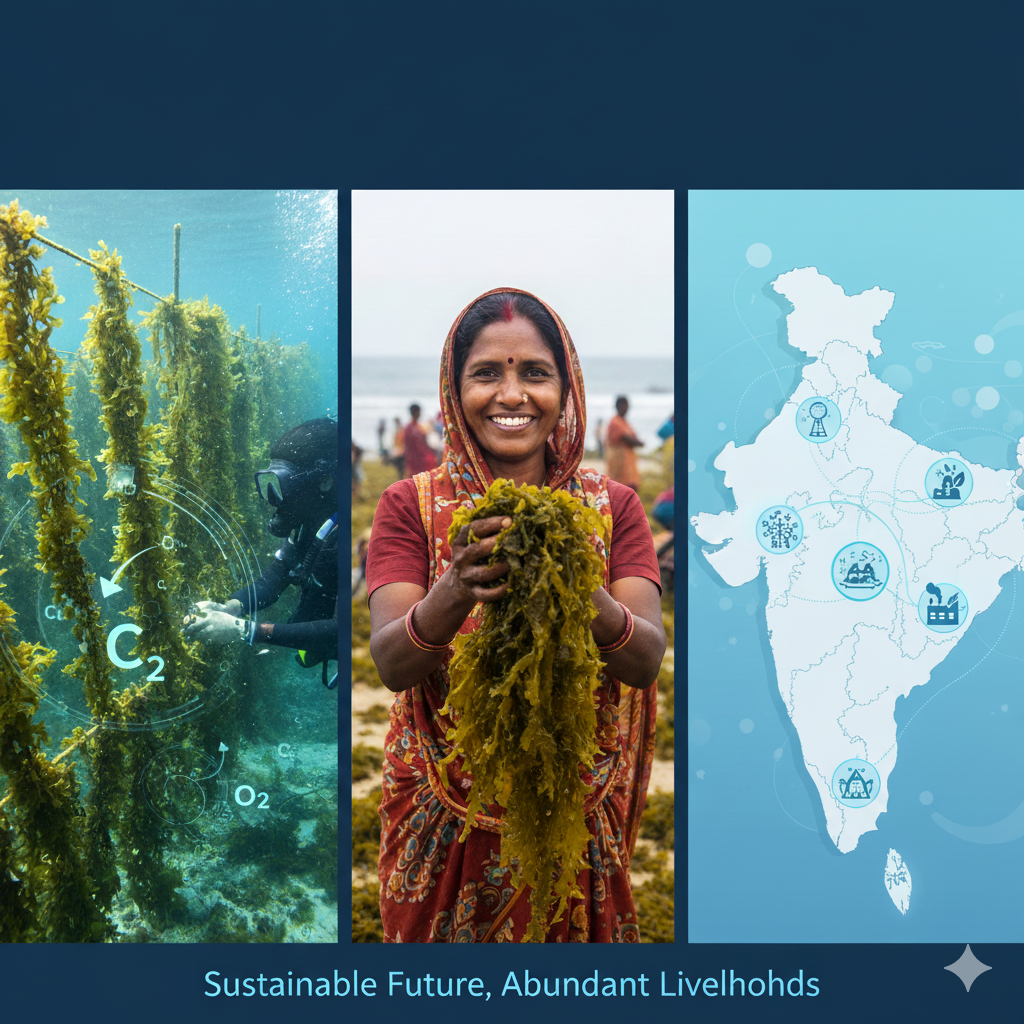
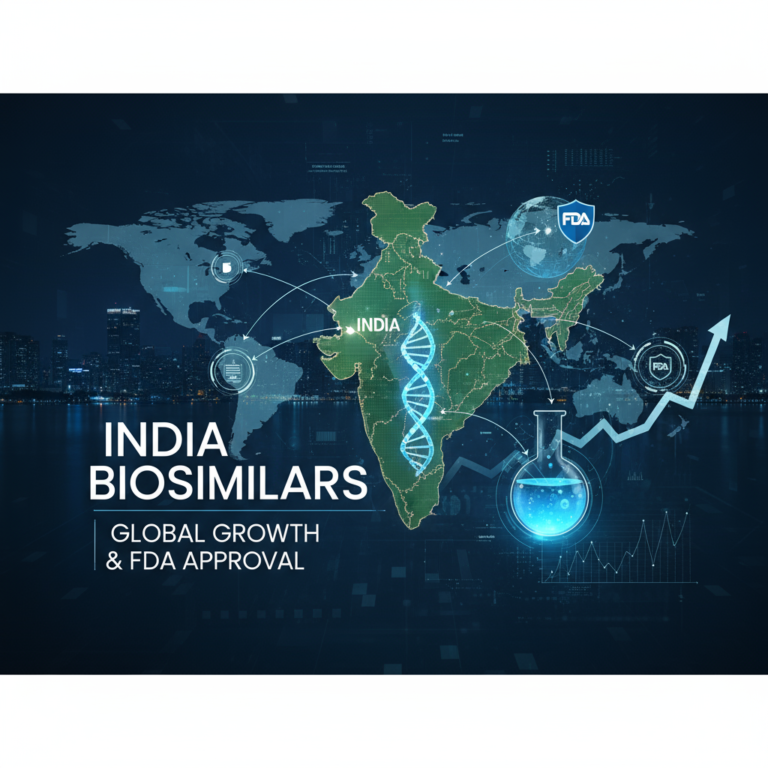
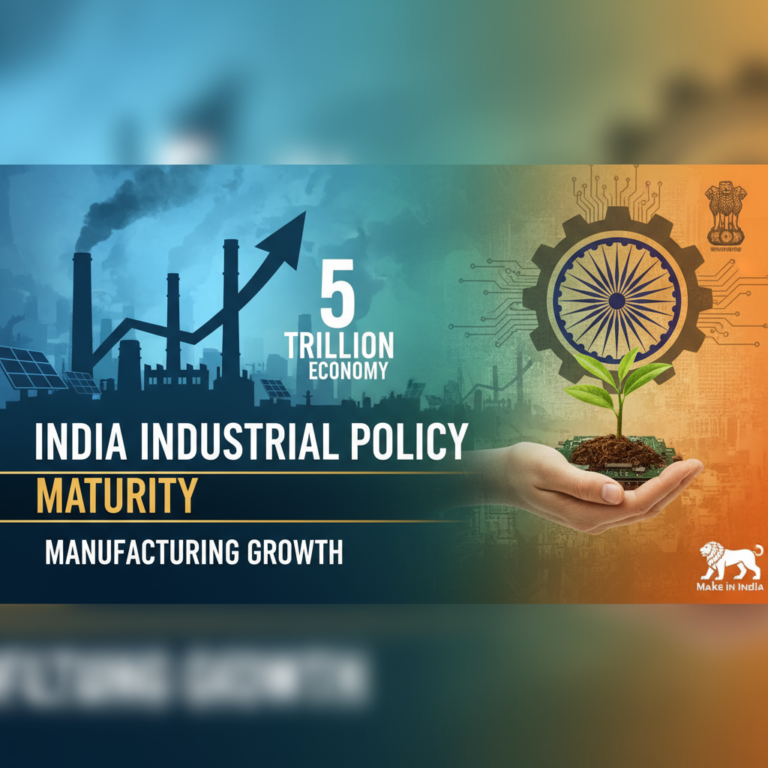

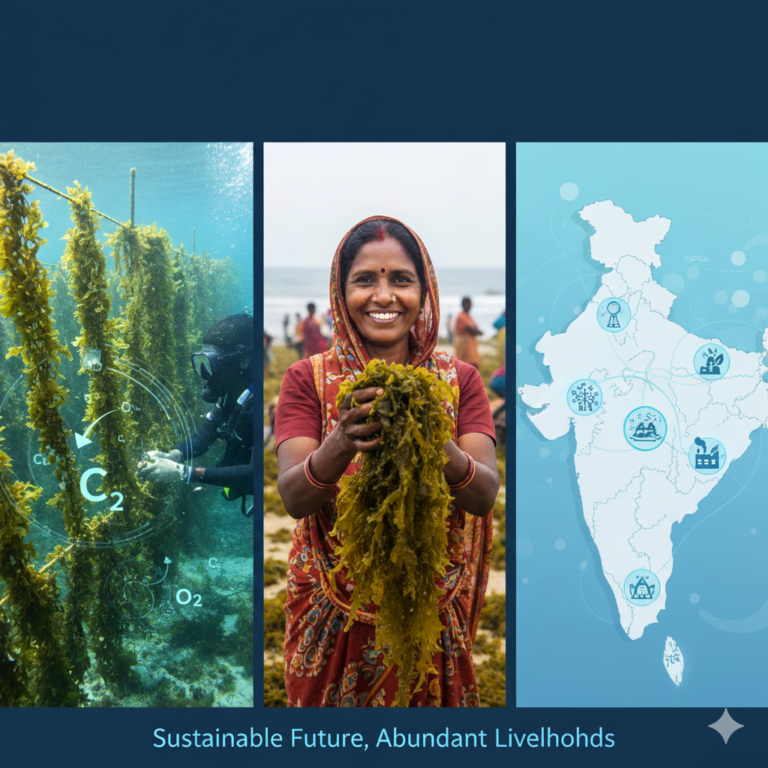

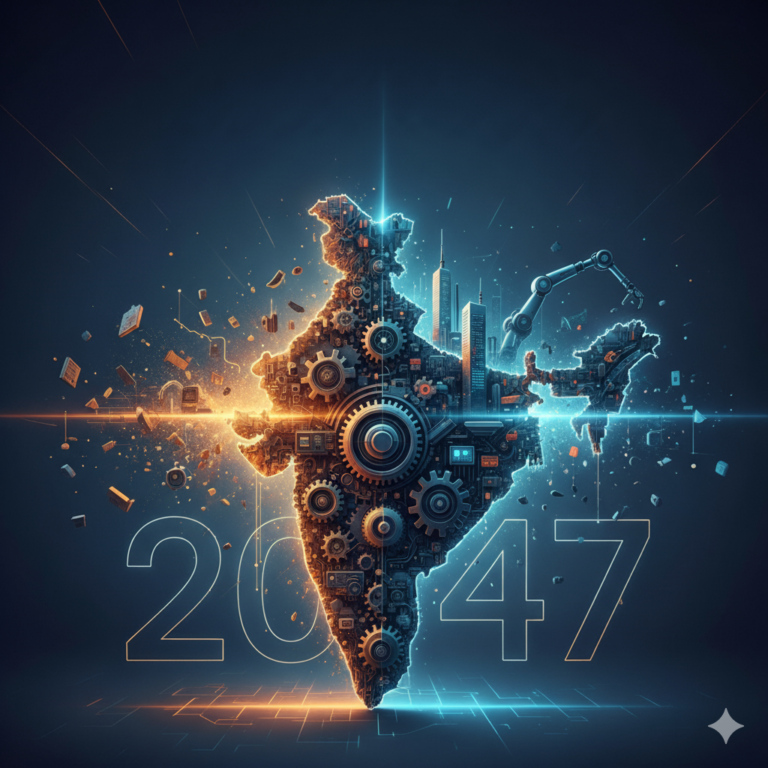
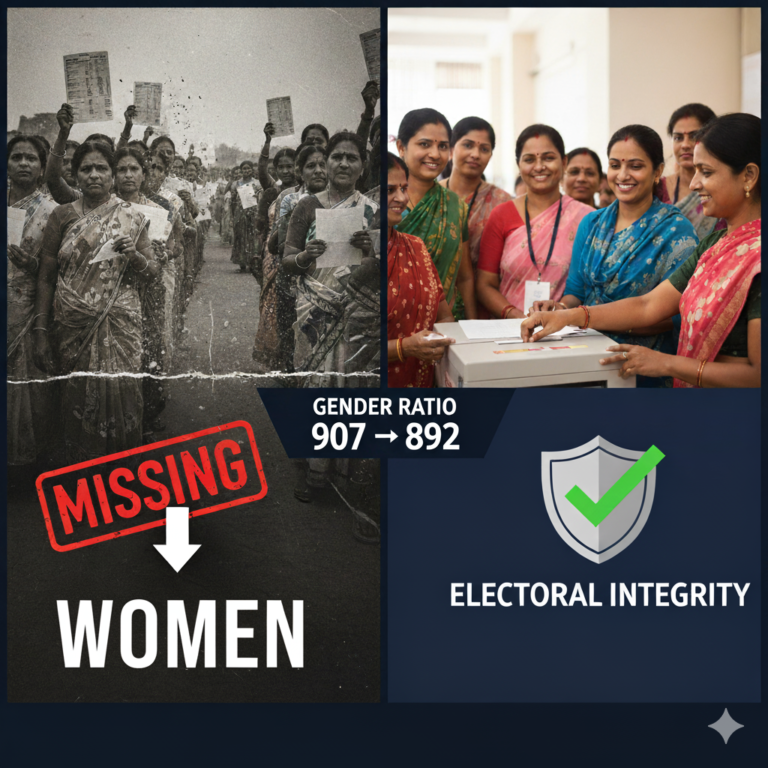

+ There are no comments
Add yours